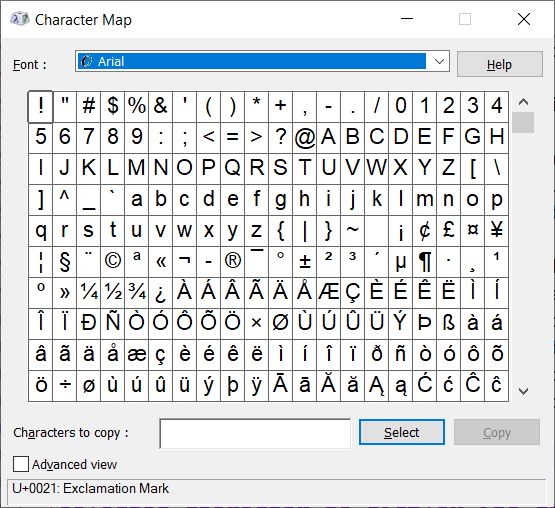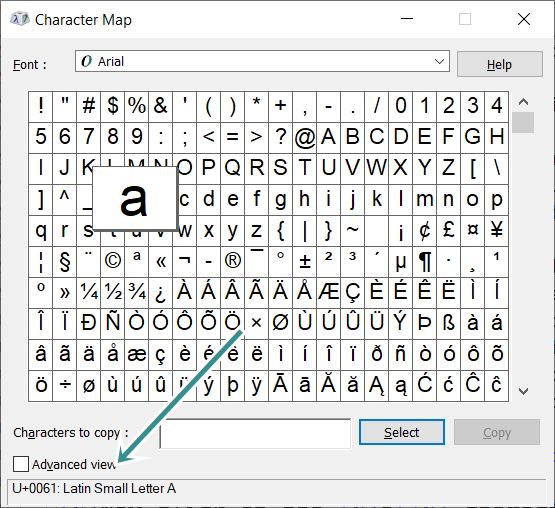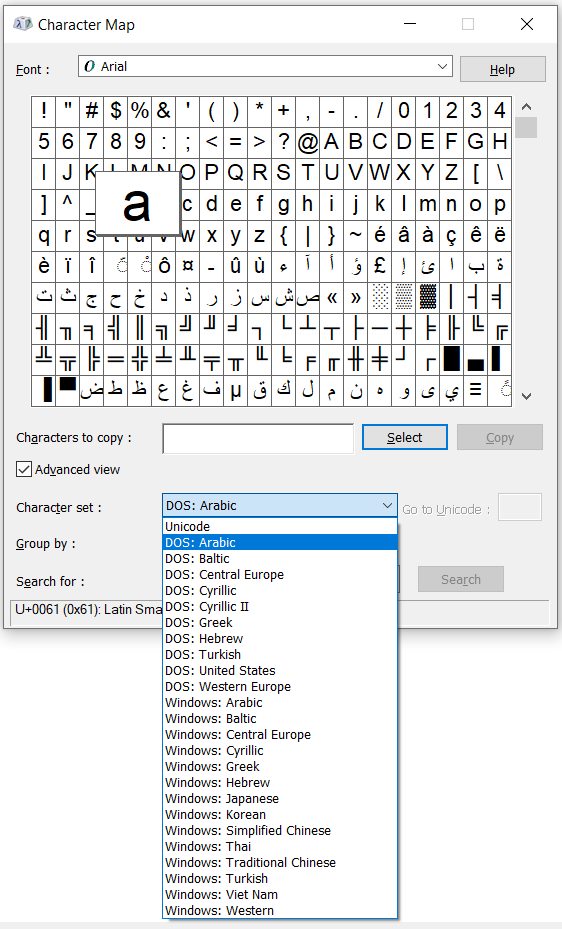- Computer Fundamentals Course
- Computer Fundamentals Tutorial
- Block Diagram of a Computer
- The Generation of Computers
- Types of Computers
- Classification of Computers
- Characteristics of Computers
- Applications of Computers
- Central Processing Unit
- Input Devices
- Output Devices
- Computer Memory and Types
- CD, HD, Floppy, and PenDrive
- Types of Computer Languages
- Types and Language Translator
- Number System with Types
- Decimal to Binary
- Decimal to Octal
- Decimal to Hexadecimal
- Binary to Decimal
- Binary to Octal
- Binary to Hexadecimal
- Octal to Decimal
- Octal to Binary
- Octal to Hexadecimal
- Hexadecimal to Decimal
- Hexadecimal to Binary
- Hexadecimal to Octal
- Algorithm and Flowchart
- Selection Sort
- Insertion Sort
- Bubble Sort
- Linear Search
- Binary Search
- Bitwise Operators
- Binary Number Addition
- EBCDIC & ASCII Code
- BCD, Excess-3, 2421, Gray Code
- Unicode Characters
Unicode Characters with Example
This post was written and distributed with the intention of elucidating the "Unicode characters," which constitute the subject that warrants the most attention when discussing computer programming languages.
Unicode is basically a universal character encoding standard that assigns a code to each and every character and symbol and is available in every language, such as English, French, Japanese, Hebrew, Russian, Mandarin, Spanish, Arabic, etc., all over the world.
Since most of the programs used in today's world are almost internationalized, the same program might produce error messages in other languages in other regions. For example, while designing the web and creating the content for the web, these languages can be used. And some of the websites also include some special characters and emoji symbols.
Let us explain Unicode in a nutshell.That being said, why do we need Unicode?
Unicode allows everyone to use their own language on a computer or phone. For instance, a character could say, I may be considered different
characters in two languages. As a result, Unicode allows for the unique identification of each and every character from all languages around the
world.
Note: Unicode assigns a code to every character all over the world. The code is an integer value. The range of the code is from 0 to 0x10FFFF. For example, the code point of a Latin small letter is 0061 or U+0061.
If you want to find out all the codes for all characters in all languages around the world, you can refer to the Character Map available on your computer system. Here is a snapshot of the opened character map:

Now click on the character a to find its Unicode value. Here is the snapshot after clicking on the a to display its code:

You can see the arrow indicated at the bottom left. The code of the selected character is displayed there. If you want to change to the "Character Set." Then, click the "Advanced View" button, and then select "Character Set" from the drop-down menu. Here is the snapshot:

A list of some well-known Unicode characters
The table that follows provides a list of some of the more significant Unicode characters, along with a brief description of each character and its associated decimal value.
| Unicode | Decimal | Output | Description |
|---|---|---|---|
| U+0000 | 0 | Null character | |
| U+0009 | 9 | Horizontal tab | |
| U+000B | 11 | Vertical tab | |
| U+007F | 127 | Delete | |
| U+0085 | 133 | Next Line | |
| U+0020 | 32 | Space | |
| U+0021 | 33 | ! | Exclamation mark |
| U+0022 | 34 | " | Quotation mark |
| U+0023 | 35 | # | Hash |
| U+0024 | 36 | $ | Dollar sign |
| U+0025 | 37 | % | Percent sign |
| U+0026 | 38 | & | Ampersand |
| U+0027 | 39 | ' | Apostrophe |
| U+0028 | 40 | ( | Opening parenthesis |
| U+0029 | 41 | ) | Closing parenthesis |
| U+002B | 43 | + | Plus sign |
| U+002D | 45 | - | Hyphen or minus |
| U+002A | 42 | * | Asterisk |
| U+002F | 47 | / | Slash |
| U+0030 | 48 | 0 | Zero |
| U+0031 | 49 | 1 | One |
| U+0032 | 50 | 2 | Two |
| U+0033 | 51 | 3 | Three |
| U+0034 | 52 | 4 | Four |
| U+0035 | 53 | 5 | Five |
| U+0036 | 54 | 6 | Six |
| U+0037 | 55 | 7 | Seven |
| U+0038 | 56 | 8 | Eight |
| U+0039 | 57 | 9 | Nine |
| U+003A | 58 | : | Colon |
| U+003B | 59 | ; | Semicolon |
| U+003C | 60 | < | Less-than sign |
| U+003D | 61 | = | Equal sign |
| U+003E | 62 | > | Greater-than sign |
| U+003F | 63 | ? | Question mark |
| U+0040 | 64 | @ | At sign |
| U+0041 | 65 | A | Capital letter A |
| U+0042 | 66 | B | Capital letter B |
| U+0043 | 67 | C | Capital letter C |
| U+0044 | 68 | D | Capital letter D |
| U+0045 | 69 | E | Capital letter E |
| U+0046 | 70 | F | Capital letter F |
| U+0047 | 71 | G | Capital letter G |
| U+0048 | 72 | H | Capital letter H |
| U+0049 | 73 | I | Capital letter I |
| U+004A | 74 | J | Capital letter J |
| U+004B | 75 | K | Capital letter K |
| U+004C | 76 | L | Capital letter L |
| U+004D | 77 | M | Capital letter M |
| U+004E | 78 | N | Capital letter N |
| U+004F | 79 | O | Capital letter O |
| U+0050 | 80 | P | Capital letter P |
| U+0051 | 81 | Q | Capital letter Q |
| U+0052 | 82 | R | Capital letter R |
| U+0053 | 83 | S | Capital letter S |
| U+0054 | 84 | T | Capital letter T |
| U+0055 | 85 | U | Capital letter U |
| U+0056 | 86 | V | Capital letter V |
| U+0057 | 87 | W | Capital letter W |
| U+0058 | 88 | X | Capital letter X |
| U+0059 | 89 | Y | Capital letter Y |
| U+005A | 90 | Z | Capital letter Z |
| U+005B | 91 | [ | Opening Square Bracket |
| U+005D | 93 | ] | Closing Square Bracket |
| U+0061 | 97 | a | Small Letter A |
| U+0062 | 98 | b | Small Letter B |
| U+0063 | 99 | c | Small Letter C |
| U+0064 | 100 | d | Small Letter D |
| U+0065 | 101 | e | Small Letter E |
| U+0066 | 102 | f | Small Letter F |
| U+0067 | 103 | g | Small Letter G |
| U+0068 | 104 | h | Small Letter H |
| U+0069 | 105 | i | Small Letter I |
| U+006A | 106 | j | Small Letter J |
| U+006B | 107 | k | Small Letter K |
| U+006C | 108 | l | Small Letter L |
| U+006D | 109 | m | Small Letter M |
| U+006E | 110 | n | Small Letter N |
| U+006F | 111 | o | Small Letter O |
| U+0070 | 112 | p | Small Letter P |
| U+0071 | 113 | q | Small Letter Q |
| U+0072 | 114 | r | Small Letter R |
| U+0073 | 115 | s | Small Letter S |
| U+0074 | 116 | t | Small Letter T |
| U+0075 | 117 | u | Small Letter U |
| U+0076 | 118 | v | Small Letter V |
| U+0077 | 119 | w | Small Letter W |
| U+0078 | 120 | x | Small Letter X |
| U+0079 | 121 | y | Small Letter Y |
| U+007A | 122 | z | Small Letter Z |
| U+007B | 123 | { | Opening curly bracket |
| U+007C | 124 | | | Vertical bar |
| U+007D | 125 | } | Closing curly bracket |
In the Unicode table above, you can see that when the code reaches the tens, alphabetical symbols, such as A, are used. Because there are only 16 symbols allowed in hexadecimal, they are 0, 1, 2, 3, 4, 5, 6, 7, 8, 9, A, B, C, D, E, and F. The characters A-F represent 10-15.
« Previous Tutorial CodesCracker.com »